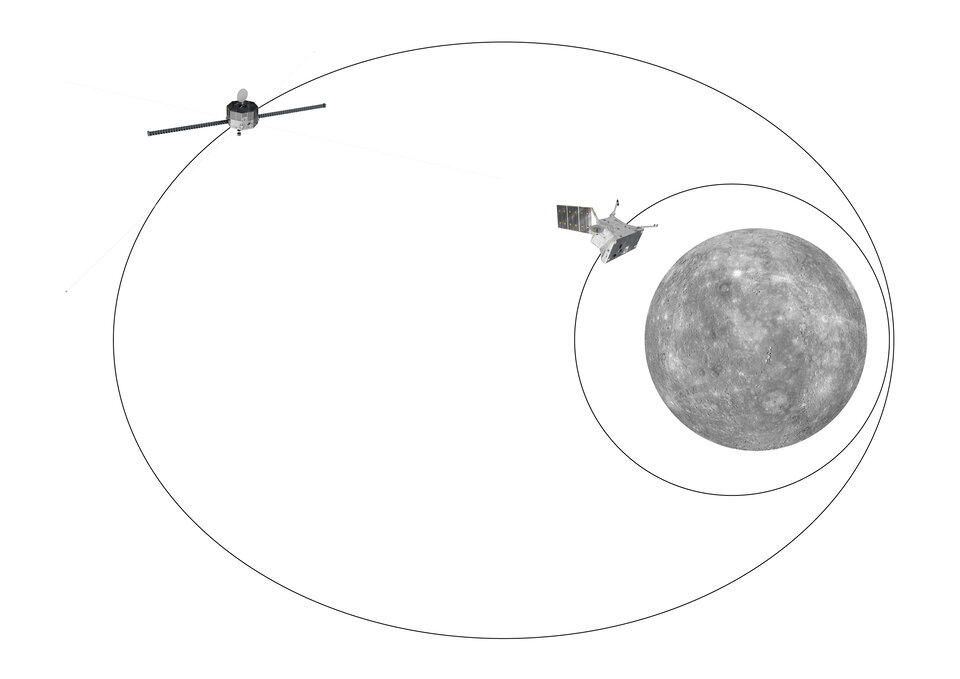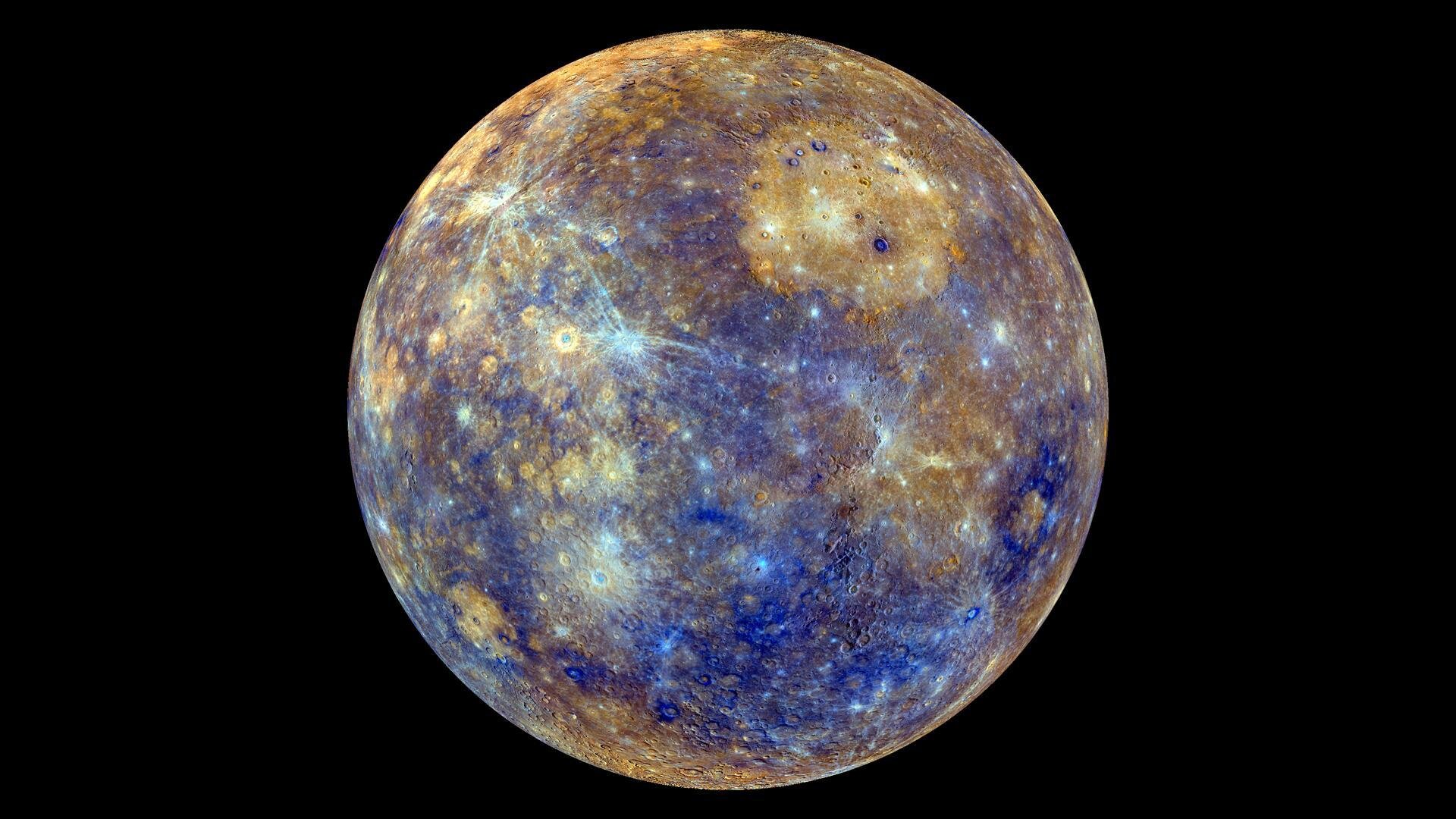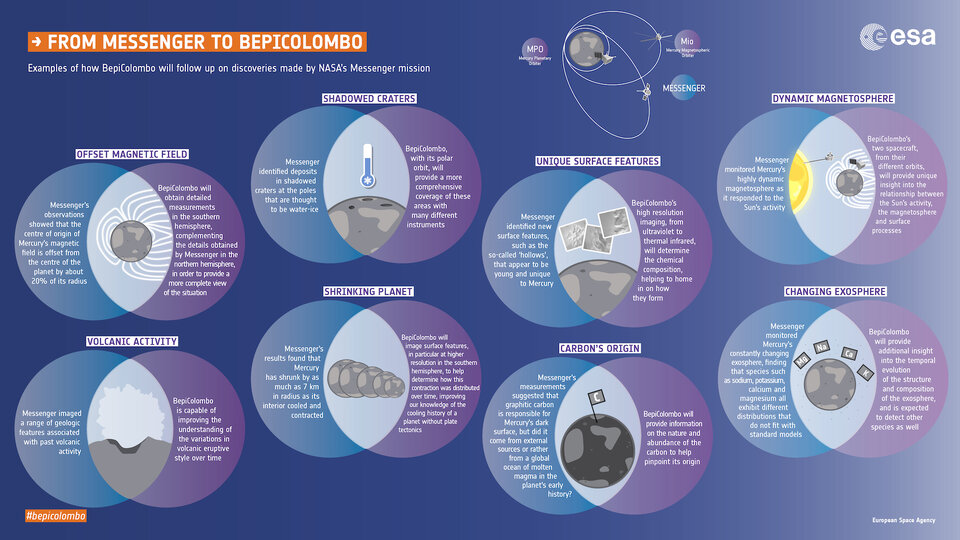From Messenger to BepiColombo
Only two spacecraft have visited Mercury so far: NASA’s Mariner‑10 and Messenger (MErcury Surface, Space ENvironment, GEochemistry, and Ranging). Mariner-10 was a flyby mission and provided the first close-up images of the planet during three passes in 1974 and 1975. Messenger also conducted three flybys – in 2008 and 2009 – before studying the planet from orbit, between March 2011 and April 2015.
BepiColombo is set to build on the achievements of NASA’s Messenger mission, to provide the best understanding of the Solar System’s innermost planet to date.
Messenger raised many questions that scientists did not even consider before the mission, which are now left open for BepiColombo to answer. Not only will the new mission provide complementary observations (separated by more than a decade) that will allow any changes to be compared and constrained, but it will make many new observations.
What’s different?

One obvious difference between the two missions is that BepiColombo comprises two spacecraft in different orbits, affording new science possibilities. In particular, dual observations are key to understanding solar-wind-driven magnetospheric processes, and this will allow unparalleled observations of the planet’s magnetic field and the interaction of the solar wind with the planet at two different locations at the same time.
ESA’s Mercury Planetary Orbiter (MPO) will orbit over the southern hemisphere of Mercury at a significantly lower altitude than achieved by Messenger, which reached its lowest altitude over the northern hemisphere. Therefore, much more detailed observations of the magnetic field in this hemisphere will be obtained, along with higher resolution images of the planet’s southern hemisphere.
Because MPO’s orbit is not highly elliptical, andmost ofthe instruments will be pointing directly towards Mercury, errors for height measurements of the surface topography will be reduced. This will allow, for example, an improvement of gravity and topography models, as well as give a higher-resolution coverage of surface features.
Investigating Mercury’s mysteries
Some examples of how BepiColombo will follow up on Messenger’s discoveries:
- Messenger’s observations showed that the centre of origin of Mercury’s magnetic field is offset from the centre of the planet by about 20% of its radius. BepiColombo will obtain detailed measurements in the southern hemisphere, complementing the details obtained by Messenger in the northern hemisphere, in order to provide a more complete view of the situation.
- Messenger identified deposits in shadowed craters at the poles that are thought to be water-ice. BepiColombo,with its polar orbit,will provide a more comprehensive coverage of these areas with many different instruments
- Messenger identified new surface features, such as the so-called ‘hollows’, that appear to be young and unique to Mercury. BepiColombo’s high resolution imaging, from ultraviolet to thermal infrared,will determine the chemical composition, helping to home in on how they form.
- Messenger identified ‘pitted terrain’, which is thought to be associated with past volcanic activity. BepiColombo is capable of improving the understanding of the variations in volcanic eruptive style over time.
- Messenger’s results found that Mercury has shrunk by as much as 7 km in radius as its interior cooled and contracted. BepiColombo will complement these results by imaging surface features, in particularly at higher resolution in the southern hemisphere, to help determine how this contraction was distributed over time. This will improve our knowledge of the cooling and tectonic history of a ‘one-plate planet’ – one that, unlike Earth, does not have plate tectonics.
- Messenger’s measurements suggested that graphitic carbon is responsible for the dark appearance of Mercury’s surface, but several theories exist as to the origin of the carbon. Did it come from external sources or rather from a global ocean of molten magma in the planet’s early history? BepiColombo will provide information on the nature and abundance of the carbon to help pinpoint its origin.
- Messenger made the first observations from orbit of Mercury’s constantly changing exosphere, finding that species such as sodium, potassium, calcium and magnesium all exhibit different spatial distributions that do not fit with standard models. BepiColombo will provide additional insight into the temporal evolution of the structure and composition of the exosphere, and is expected to detect other species in the atmosphere as well.
Just as Messenger dramatically improved our knowledge of this fascinating world, no doubt BepiColombo in turn will find new surprises and make unexpected discoveries that will have important implications for our understanding of the planet’s place in Solar System history.















 Germany
Germany
 Austria
Austria
 Belgium
Belgium
 Denmark
Denmark
 Spain
Spain
 Estonia
Estonia
 Finland
Finland
 France
France
 Greece
Greece
 Hungary
Hungary
 Ireland
Ireland
 Italy
Italy
 Luxembourg
Luxembourg
 Norway
Norway
 The Netherlands
The Netherlands
 Poland
Poland
 Portugal
Portugal
 Czechia
Czechia
 Romania
Romania
 United Kingdom
United Kingdom
 Slovenia
Slovenia
 Sweden
Sweden
 Switzerland
Switzerland


























